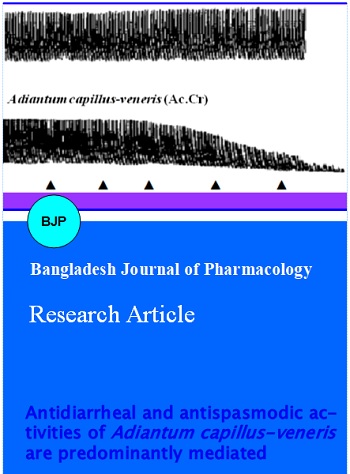Antidiarrheal and antispasmodic activities of Adiantum capillus-veneris are predominantly mediated through ATP-dependent K+ channels activation
DOI:
https://doi.org/10.3329/bjp.v10i1.21869Keywords:
Adiantum capillus-veneris, Antidiarrheal, Antispasmodic, ATP-dependent K channel activationAbstract
The study was tempted to explore the scientific basis for the medicinal use of Adiantum capillus-veneris L. in diarrhea using the in vivo and in vitro assays. The crude extract of dried leaves of A. capillus-veneris exhibited antidiarrheal effect against castor oil-induced diarrhea in mice at 300 and 500 mg/kg, similar to the effect loperamide. It was also found safe up to administered dose of 7 g/kg in mice. In isolated rabbit jejunum, extract of A. capillus-veneris showed a concentration-dependent relaxation of spontaneous and low K+ (25 mM)-induced contractions and had weak inhibitory effect on high K+ (80 mM), similar to the activity pattern of cromakalim, an ATP-dependent K+ channel opener. Interestingly, its inhibitory effect on spontaneous contractions was potentiated in the presence of atropine. These data demonstrates that A. capillus-veneris possesses antidiarrheal and antispasmodic properties mediated possibly through ATP-dependent K+ channels activation, thus providing scientific basis to its folk use in abdominal colic and diarrhea.
Downloads
464
328 Read
259

Published
How to Cite
Issue
Section
License
Authors who publish with this journal agree to the following terms:
- Authors retain copyright and grant the journal right of first publication with the work simultaneously licensed under a Creative Commons Attribution License that allows others to share the work with an acknowledgement of the work's authorship and initial publication in this journal.
- Authors are able to enter into separate, additional contractual arrangements for the non-exclusive distribution of the journal's published version of the work (e.g., post it to an institutional repository or publish it in a book), with an acknowledgement of its initial publication in this journal.
- Authors are permitted and encouraged to post their work online (e.g., in institutional repositories or on their website) prior to and during the submission process, as it can lead to productive exchanges, as well as earlier and greater citation of published work (See The Effect of Open Access).
